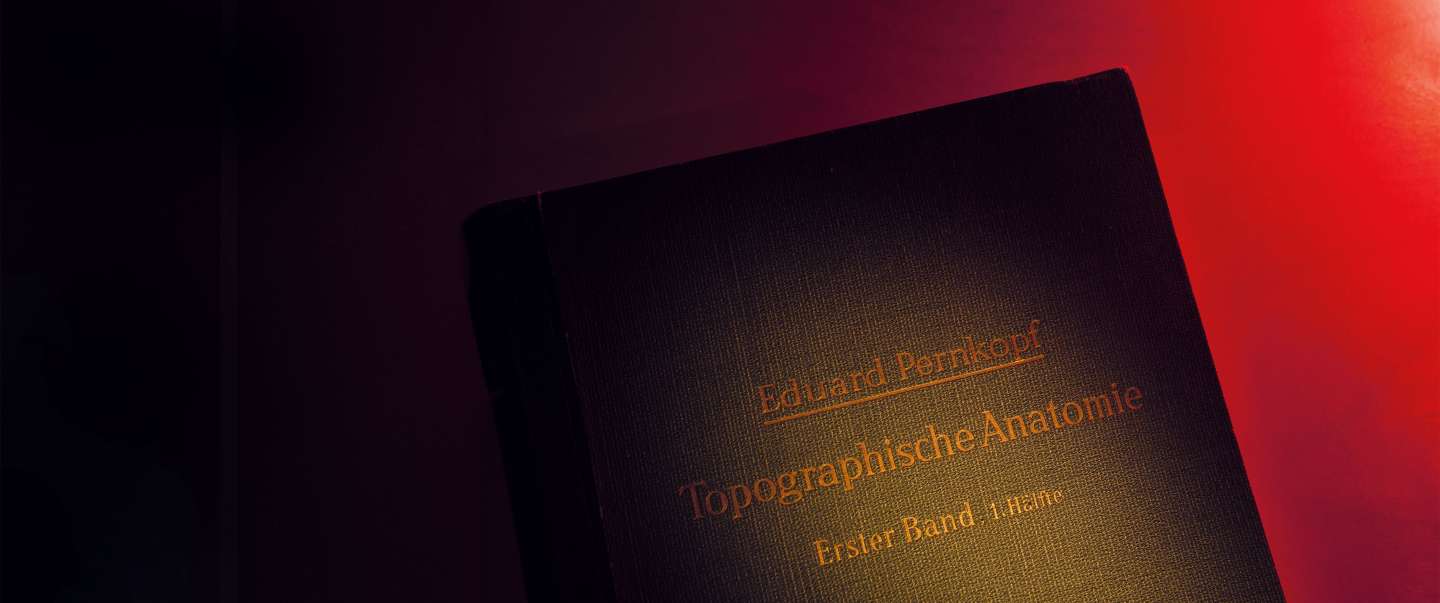
This human anatomy atlas has a horrific history. One doctor aims to lessen its influence
Warning: Some of the images in this story may be disturbing.
Part 1 of 2
As the oldest scientific discipline in medicine, anatomy dates at least as far back as the ancient Egyptians, whose elaborate embalming methods necessitated a familiarity with organs and body parts. Hippocrates described the heart and blood vessels in establishing medicine as a scientific field in the 5th century BC. In modern times, generations of aspiring doctors have learned about anatomy in their first year of medical school, in part by dissecting human cadavers in the lab.
But this is not a story about anatomy, per se.
It is a story about an avowed Nazi physician, Dr. Eduard Pernkopf, during the time of the Holocaust, who ascended to the highest post at one of Europe’s most prestigious medical schools and violated the Hippocratic Oath in the most egregious way — exploiting the bodies of executed victims of Nazi terror to create a multivolume series of atlases of the human anatomy. For decades, those atlases were held up as preeminent resources, guiding complex surgeries and teaching medical students. Even after the shameful history was revealed, many considered the information in these tainted volumes too valuable to discard.
And it is a story of a UCLA Health physician who, revolted by the origins of the atlas, has made it his mission to right what he sees as an abhorrent historical wrong. Kalyanam Shivkumar, MD (FEL ’99), PhD ’00 — “Shiv” to those who know him — has built an internationally renowned program as director of the UCLA Cardiac Arrhythmia Center. A leading innovator of heart procedures with a penchant for quoting Sanskrit and legendary UCLA basketball coach John Wooden, Dr. Shivkumar found himself unable to let go of his disgust upon learning of the story behind the atlases in 2012. So, he channeled his indignation into a 10-year effort, with the help of UCLA colleagues, to create a new and better resource and make it freely available to anyone.
“EVEN IN A PROFESSION THAT IS SWORN TO PROTECT AND HEAL, HUMAN BEHAVIOR CAN SINK INTO VERY LOW AND DIABOLICAL PLACES."
“What Shiv has done is inspiring,” says Barbara Natterson-Horowitz, MD (RES ’90, ’92, FEL ’95), a UCLA professor in the Division of Cariology and codirector of the UCLA Evolutionary Medicine Program. “In contrast to Pernkopf’s documents of death, his anatomic atlases will be powerful tools for saving lives.”
And lastly, this is the story of an undertaking much larger than that ambitious initial act. Shortly before the release of the first of six planned volumes of the Atlas of Cardiac Anatomy, Drs. Shivkumar and Natterson-Horowitz established Amara Yad — a combination of Sanskrit and Hebrew translating to “The Immortal Hand.” The project has set out to produce as many as 40 open-access anatomic atlases, leveraging scientific and technological advances to map the entire human body as a resource for future clinicians and researchers.
More than that, the Amara Yad Project will educate medical students, trainees and others on past and present moral stains on the profession while supporting corrective measures that address the damage, restore trust and educate a new generation of physicians on their sacred duty to ethically serve their patients.
“Even in a profession that is sworn to protect and heal, human behavior can sink into very low and diabolical places,” says Liebe Geft, who, just before her retirement as director of the Museum of Tolerance in October, hosted an event at the Los Angeles venue in honor of the Amara Yad launch. “We can never condone abuse of the power, authority and privilege placed in the hands of the medical practitioner for the sake of some spurious notion of scientific advance.”
The Amara Yad Project epitomizes a central element of the mission of the David Geffen School of Medicine at UCLA, says Steven M. Dubinett, MD (RES ’84), the school’s dean. “We spend a lot of time on technical education, but there is a moral imperative to our jobs as well. We must clearly articulate our values in a way that lets our community of patients, as well as our students, trainees and physicians, understand that we are in health care because we’re about healing — and that the best way to demonstrate that is not only through compassionate care, but also attention to our history,” he says. “It makes me proud that we have faculty who have taken this on.”
1,377 bodies
For decades, anatomists and surgeons regarded Topographische Anatomie des Menschen (Atlas of Topographical and Applied Human Anatomy) with awe.
Published in seven volumes from 1937 to 1960, the series — best known as the “Pernkopf atlas,” after Dr. Pernkopf, the Austrian anatomist who oversaw the work — used hand-drawn illustrations to display human bones, muscles, nerves, tendons and tissue in vivid color and graphic, annotated detail. As both an artistic work and a clinical resource, the Pernkopf atlas was viewed as unsurpassable — lauded as late as 1990 by a New England Journal of Medicine review as “in a class of its own.” The Journal of the American Medical Association declared it a “classic among atlases,” calling its illustrations “truly works of art.”
Only later would the source of the endless supply of cadaver subjects featured in the atlas’ pages become clear.
In 1933, the year Dr. Pernkopf was appointed chair of anatomy at the University of Vienna, he joined the Nazi party. Weeks after the Anschluss, when Nazi Germany invaded and annexed Austria into the Third Reich in 1938, Dr. Pernkopf was appointed dean of the medical school. He proceeded to dismiss nearly 80% of the school’s faculty, including all Jews and other Nazi opponents, three Nobel laureates among them. The remaining professors were required to swear an oath of loyalty to Hitler. In a chilling photograph taken just days after he assumed the leadership post, Dr. Pernkopf, dressed in full Nazi regalia with a portrait of Hitler behind him, stands at the lectern for his inaugural address to faculty, who greet him with the Nazi salute.
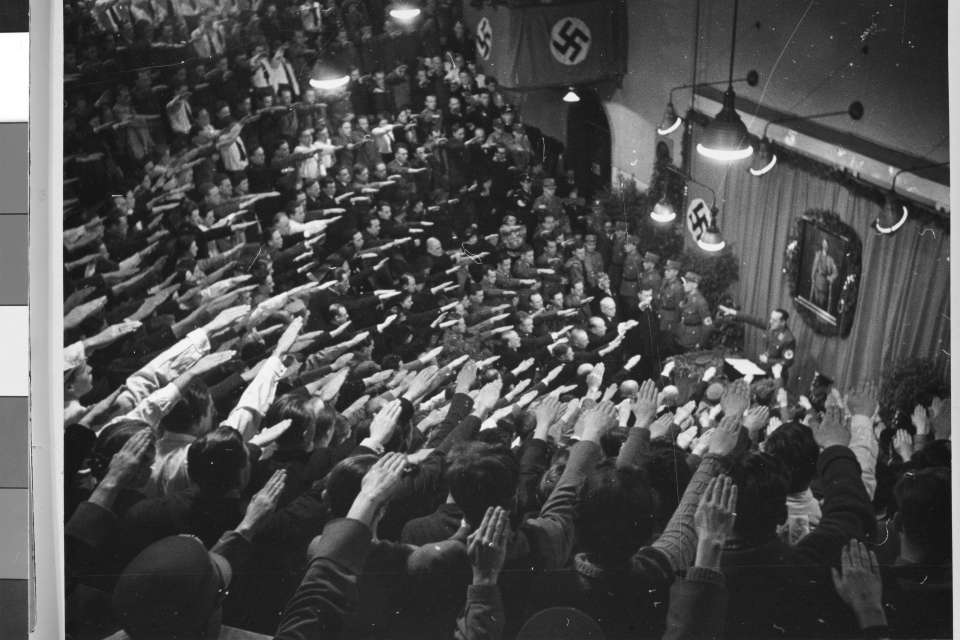
Although Dr. Pernkopf’s vile past wasn’t entirely a secret, decades passed during which his works remained widely used while their source was barely discussed. That began to change in the 1980s through revelations and disturbing questions raised in a series of journal articles and letters. Among other things, the four main medical artists employed by Dr. Pernkopf were themselves proud Nazis who, in the early editions of the atlas, signed their illustrations with swastikas and other Nazi symbols — crudely airbrushed out in later editions.
By the mid-1990s, new published papers questioned the source of the cadavers Dr. Pernkopf’s team had used. After prodding from Yad Vashem, the World Holocaust Remembrance Center based in Jerusalem, the University of Vienna launched an investigation. The university’s report confirmed the suspicions: From 1938 to 1945, the anatomy department under Dr. Pernkopf received at least 1,377 bodies of executed people, the majority of them political prisoners targeted by the Nazi regime. In all likelihood, the report concluded, images of the dissected bodies of these individuals were strewn across the atlas’ pages.
“It became quite obvious that there was this extremely distressing suppressed history,” Dr. Shivkumar says. “Pernkopf received the bodies of people imprisoned and murdered for trivial crimes — and these murders were timed for when it was convenient to the team that was using the bodies to make the atlases.”
In the preface to the first edition, Dr. Pernkopf credits the vivid images in part to the access his group had to an endless supply of bodies. “He owns it, and not in an apologetic way,” Dr. Natterson-Horowitz says. “Here is a physician, leader of a top medical school, with a total lack of awareness or shame about using these victims.”
'All roads led to Pernkopf'
Dr. Shivkumar was unfamiliar with the Pernkopf history in 2002, the year he established the UCLA Cardiac Arrhythmia Center. As an electrophysiologist, his focus is on abnormal heart rhythms. Although most arrhythmias are benign, an improperly beating heart can negatively affect blood flow to vital organs. As many as 6 million Americans have atrial fibrillation, which can produce palpitations, chronic fatigue and shortness of breath that severely impede quality of life. In the most lethal cases, untreated arrhythmias can lead to cardiac arrest or stroke.
Under Dr. Shivkumar’s leadership, the UCLA Cardiac Arrhythmia Center has risen to international prominence, drawing referrals and consultations for some of the most complicated cases. Among other innovations, his group has developed new techniques for treating ventricular tachycardia, a potentially life-threatening arrhythmia in which the heart’s lower chambers beat too quickly. Dr. Shivkumar is also a leader in the field of neurocardiology — the complex interplay between the nervous and cardiovascular systems and how targeting certain nerves can effectively treat ventricular arrhythmias. In September 2023, his group received an $11.5 million National Institutes of Health grant to study the use of nervous system modulation to prevent fatal arrhythmias.
It was Dr. Shivkumar’s determination to venture outside the heart and into the body’s nervous system that led him to Dr. Pernkopf.
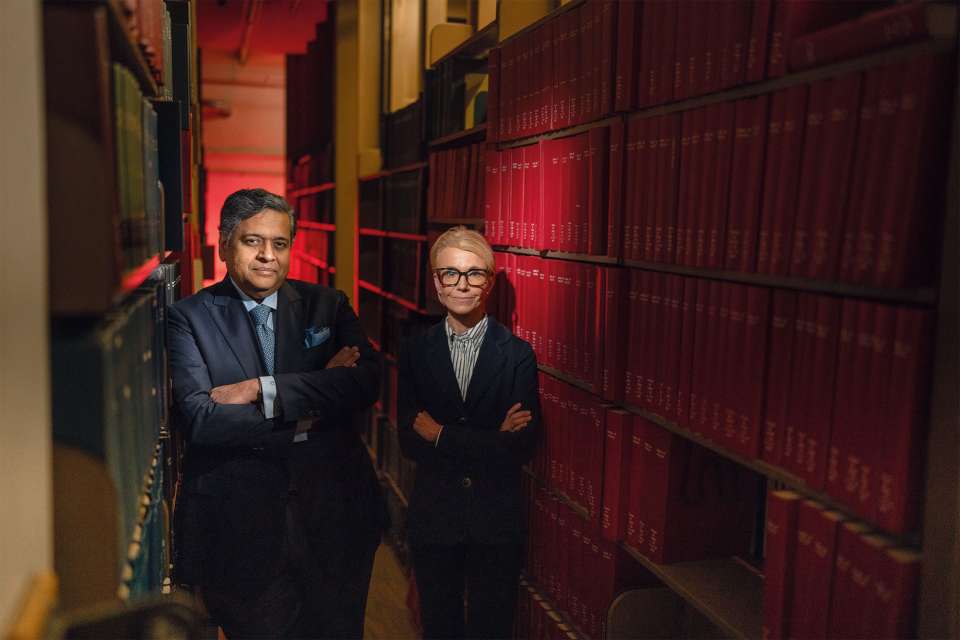
In 1975, Wallace A. McAlpine, MD, a cardiac surgeon in Toledo, Ohio, published an anatomic atlas of the heart and coronary arteries, featuring highly detailed photographic images of the cardiac anatomy. “He converted the basement of his house into a studio to take pictures using Kodachrome film,” Dr. Shivkumar says. “The result was a work of art.”
Dr. Shivkumar came across that atlas not long after Dr. McAlpine’s death in 2005, then went hunting for the original images. Ultimately, he found the collection of approximately 4,000 slides in the basement of the Cleveland Clinic Library, acquired them and digitized Dr. McAlpine’s work, making it freely available.
But by 2010, Dr. Shivkumar recognized that nerve modulation was becoming a key to treating conditions involving the cardiovascular system, and as valuable as the McAlpine atlas was for mapping the heart, it was confined to that organ. So, Dr. Shivkumar began to inquire about anatomic resources that provided a detailed map of the peripheral nerves to assist his group in developing new procedures. And among those in the know, the definitive resource was clear. “All roads led to Pernkopf,” Dr. Shivkumar says.
In 2012, a Canadian colleague gifted Dr. Shivkumar an entire set of the Pernkopf atlas, but in doing so shared the painful history. “Shiv was shaken by this,” Dr. Natterson-Horowitz recalls of her friend and colleague. “He was offended by what happened, and by the fact that so many generations of physicians had used either Pernkopf or a newer atlas informed by the Pernkopf work, without knowledge of the history. He became fixated with getting to the bottom of this. I would come into his office to find him meeting with rabbis, trying to learn more.”
More than a decade later, Dr. Shivkumar still becomes emotional when the subject is raised. “It’s an insult to humanity,” he says. “How can medicine have such a stain?”
'Basic humanity'
Kalyanam Shivkumar was born in 1968 in Chennai (then called Madras), located on the Bay of Bengal in southeastern India. His father was a mathematician, his mother a chemistry teacher. His grandfather had been a journalist who spent eight years in prison after being charged with sedition for publishing a newspaper directed by Mahatma Gandhi; he was released after India achieved independence in 1947 and went on to serve as a member of parliament.
Dr. Shivkumar still recalls his first exposure to the horrors of the Holocaust, when he was about 12. His grandfather brought in a friend, a British war photographer, to show pictures from the concentration camps. “You have to understand, in the part of the world I’m from, for millennia people from all religions, cultures and ethnic groups have coexisted,” Dr. Shivkumar says. “I’ll never forget seeing those photos and having my dad and grandfather tell me, quoting Primo Levi, ‘This happened, it could happen again, and it could happen anywhere.’”
Dr. Shivkumar describes his own family as Hindu Brahmin, and he was raised reading Sanskrit. But, while he remains rooted in Hindu values, he dismisses the suggestion that his moral outrage at Dr. Pernkopf and other atrocities associated with the Holocaust is informed by his faith. “It’s basic humanity,” Dr. Shivkumar says. “Which faith would contradict this? Gandhi, when asked if he was a Hindu, said ‘Yes, I am. I am also a Muslim, a Christian, a Sikh, a Buddhist and a Jew.’”
KNOWING THE SORDID ORIGIN STORY BEHIND THE PERNKOPF ATLAS RAISED A MORAL DILEMMA.
Dr. Shivkumar immigrated to the U.S. after graduating from medical school. He came to UCLA in 1995 as a cardiology and electrophysiology fellow. One of Dr. Shivkumar’s first attending physicians was Dr. Natterson-Horowitz, then a first-year faculty member. She remembers him standing out for more than his technical skills. “Shiv had an unusual fund of knowledge,” she says, “which included the ability to quote from wide-ranging sources — Maimonides and Osler, Ramakrishna and Shalihotra, and, after a few months at UCLA, John Wooden.”
Whether he’s delivering a professional talk or engaged in one-on-one conversation, Dr. Shivkumar is more likely than not to reference the legendary UCLA basketball coach. In his office at the UCLA Cardiac Arrhythmia Center, he proudly displays an autographed, framed poster of Wooden’s oft-cited Pyramid of Success, the universal road map for team and individual excellence. “Wooden said it very beautifully — that he deeply cared about what is right, not who is right,” Dr. Shivkumar says.
Another favorite Wooden quote spoke to Dr. Shivkumar as he began to ponder an effort to render Dr. Pernkopf’s work irrelevant. The quote was about basketball but, like so many credited to the Wizard of Westwood, it applied to life: “It’s not so important who starts the game, but who finishes it.”
A moral dilemma
After its contemptible history was exposed, the Pernkopf atlas remained highly influential — seen as an irreplaceable resource that could save lives, even if its authors shamefully disregarded them. It was published in five languages from 1960 to 1990. Although it went out of print after the history was revealed, secondhand copies — fetching, in some cases, thousands of dollars — can still be found, including on Amazon.
But if few copies of the originals remain in circulation, many Pernkopf images have appeared, in some form, in other publications. “For any anatomist who was creating an atlas following Pernkopf, it would be surprising if they had not consulted the Pernkopf atlas, and you can see the influences,” Dr. Natterson-Horowitz says.
Knowing the sordid origin story behind the Pernkopf atlas raised a moral dilemma. If the books contained critical information that could be used for the benefit of patients, should they nonetheless be disregarded given that the information came from the exploitation of Nazi victims?
On the one hand, some have argued, the knowledge derived from the Pernkopf work — and from other incidents of unethically produced science throughout history — can’t simply be erased and applying the knowledge to improving lives honors the victims. Others counter that the evil doings can’t be separated from the work and condoning the atlas’ continued use opens the door to future moral and ethical transgressions that rely on the ends to justify the means.
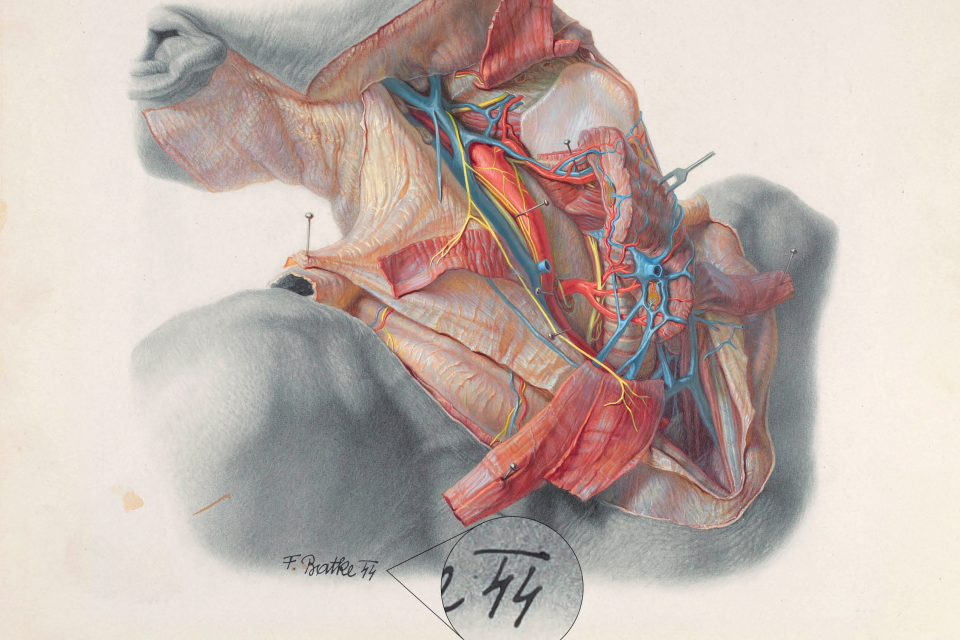
In particular, the Pernkopf work was viewed as peerless when it came to its utility for peripheral-nerve surgeons. In 2015, Susan E. Mackinnon, MD, a leading nerve surgeon at Washington University in St. Louis who had long leaned on the illustrations to guide complex pain operations, approached Sabine Hildebrandt, MD, a pediatrician and lecturer in global health at Harvard Medical School and an expert in the history of anatomy during the Third Reich, about her misgivings.
They consulted leading scholars in Jewish medical ethics — including Rabbi Joseph Polak, who survived the Westerbork and Bergen-Belsen concentration camps as a child while losing his father and 30 other family members in the Holocaust.
The scholars issued a document on the case, known as the Vienna Protocol, that was formally adopted in 2017 by a group of experts at Yad Vashem. It concluded, based on Jewish law, that the Pernkopf images should be utilized if they were helping to save a life, as long as the patient was aware of the history and consented: “In this way, the dead are accorded at least some of the dignity to which they are entitled.”
While Dr. Shivkumar found the conclusion “touching, and it shows how noble people can be,” he had other ideas. “I was repulsed” at the thought of the Pernkopf works continuing to find circulation, he says. “It didn’t sit with me very well.”
Taking up the challenge
As Dr. Shivkumar saw it all, all of the wrestling with how and whether the Pernkopf atlas should continue to serve as a resource was based on the premise that replacing Dr. Pernkopf’s work was insurmountable. For decades, no serious effort had been undertaken to surpass it. Now, fueled by his moral outrage, Dr. Shivkumar was ready to summon his team to take up the challenge. “Why should we have to choose?” he says. There would be no ethical quandary if the product of Dr. Pernkopf’s evil became obsolete.
Among the rabbinic scholars he consulted was Michael Berenbaum, an author and professor at American Jewish University in Los Angeles, where he is director of the Sigi Ziering Institute: Exploring the Ethical and Religious Implications of the Holocaust.
After several meetings with Dr. Shivkumar and his team, Rabbi Berenbaum says, “we were profoundly impressed by their commitment to providing an ethically normative means by which to guide surgeons and others grappling with the structure and nature of the heart.”
Rabbi Berenbaum likens knowledge stemming from Dr. Pernkopf’s atlas to fruit from a poisonous tree. “These are ill-gotten gains,” he explains. “Even though the information is essential, we would not want to be the beneficiary of those medical crimes. We want to find that knowledge in a manner that doesn’t violate ethical decency, norms and propriety.”
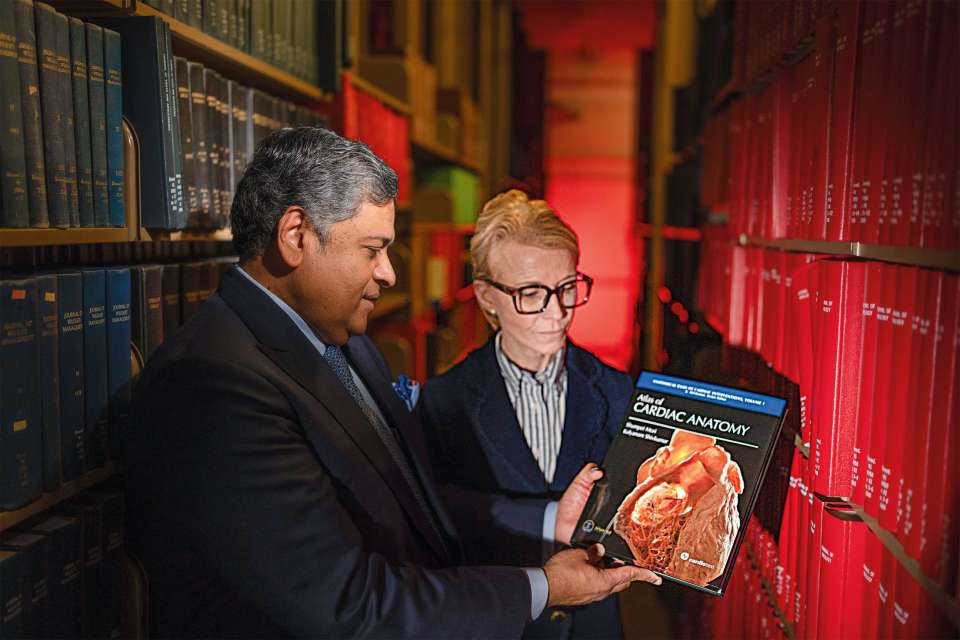
Dr. Shivkumar also reached out to Richard S. Panush, MD, a rheumatologist who had taken a public stand against the Pernkopf atlas after a 1995 Annals of Internal Medicine article set off the chain of events that led to the University of Vienna investigation. Dr. Panush, then at St. Barnabus Medical Center in Livingston, New Jersey, was deeply disturbed by the recollections of Edzard Ernst, MD, PhD, a former Vienna Medical School faculty member who wrote of the Nazi takeover of the university and raised the likelihood that Nazi victims were used as research subjects.
When Dr. Panush found the atlas in his hospital’s library, he recoiled. He wrote a letter in response to the Annals article, detailing the actions he took following that discovery — including getting his institution to remove the atlas from circulation, place it in a case with a historical explanation and offer the display in a cautionary context.
Dr. Shivkumar struck up a friendship with Dr. Panush, who is now an emeritus professor at USC, and has used his sentiments as a call to action. “Dr. Panush said our obligation is to repudiate Pernkopf and all he stood for,” Dr. Shivkumar says. “He said we cannot forget that Pernkopf’s character and actions were so abhorrent as to irrevocably taint this work. I share that belief.”
So, in 2012, Dr. Shivkumar set out to surpass Dr. Pernkopf. He vowed that he and his team would create an anatomic atlas of the entire body, starting with the heart. They would make it open access, so that all members of the medical and surgical community could benefit. And they would remove the need for anyone to consult the work of Dr. Pernkopf — the fruit from the poisonous tree. “When you discover that the foundation of what you thought of as a beautiful building is rotten, you don’t keep building on it,” Dr. Shivkumar says.
“What Shiv is doing is absolutely heroic,” Dr. Panush asserts. “He has totally changed the conversation. If the atlas becomes obsolete, all of these other issues become moot.”
Of course, there was a reason no one had tried to surpass the Pernkopf atlas before. “When I told the anatomists we were doing this, they said it was impossible,” Dr. Shivkumar says. “But as electrophysiologists, we have not come across any arrhythmia we’re not able to manage. So, I said, ‘We have done harder things. This is doable.’”
